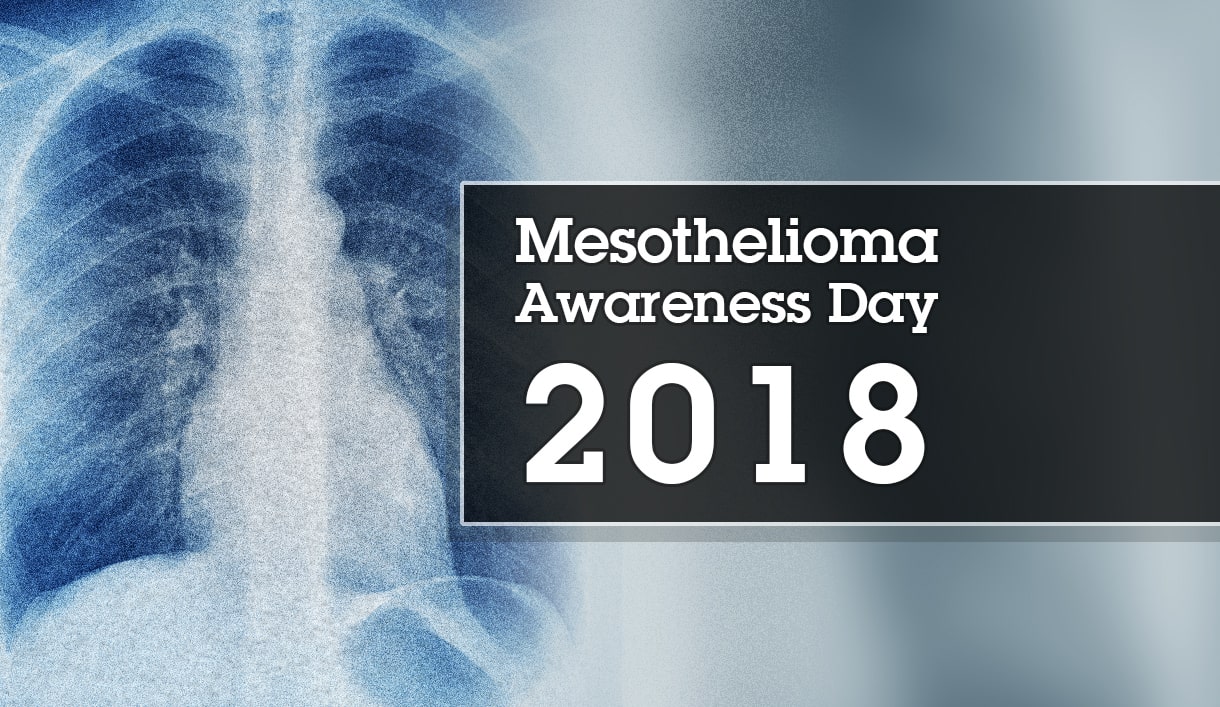Mesothelioma Awareness Day 2018
Asbestos we meet again
If you’ll excuse an odd momentary detour, I’d like to outline an analogy for the situation I find myself facing here.
As an avid comic book fan, I love the fantastical nature of the DC and Marvel properties. Batman, Spiderman, X-men, The Avengers; they all have a place in my past and present love of the medium and its related properties such as films. There’s just one slight problem, a nagging sensation of dissonance that I can’t quite let go. As much as I love them, I also absolutely hate them.
Why? Simple really, it’s the lack of finality. Issues are never truly resolved, villains never quite stay vanquished and you can bet sometime in the next decade or two they’ll kill and resurrect Superman again, acting like it’s still a shocking twist. The sensation of travelling in circles never quite goes away.
What on earth am I talking about and what does this have to do with writing about Mesothelioma Awareness Day 2018? It’s the déjà vu, suddenly I feel like I’m travelling in circles again.
Today I’d like to talk to you again about a real-world villain; a vicious and remorseless killer responsible for the deaths of thousands-upon-thousands of factory workers, electricians, miners, shipbuilders and construction workers.
They’ve plagued this planet since at least the industrial revolution with origins going all the way back to ancient Greece. They’re back this year and they’re getting stronger. Ladies and gentlemen, please give all your boos and hisses for the monster we’ve been trying to kill for more than a century!
“Asbestos we meet again.”
The asbestos menace and mesothelioma
Okay, a fairly exaggerated start there, but this is far from the first time we’ve written about the asbestos menace.
Last year when the Mesothelioma & Asbestos Awareness Centre (MAAC) asked if I would collaborate to produce a blog I jumped at the chance as I had plenty to get off my chest. I didn’t hold anything back and wrote what I now look back on as one of my more scathing blog contributions. I started my blog with the title ‘asbestos kills‘ and thought I was being brutally direct on the matter.
The thing is, that in spite of much of the cynicism I committed to that post, I wrote it with a genuine hope that things might get better in the next few years. What I didn’t anticipate was that they might actually get worse.
In June 2018 The USA’s Environmental Protection Agency (EPA) issued new rules regarding Asbestos use within the country*1. This raised a few eyebrows to say the least, as some of the fine print presents cause for concern.
Historically the EPA has attempted to completely ban asbestos on a few occasions since the 1970s, and on the face of it this rule supposedly strengthens regulation on the material, however critics point out that there is potential for exploitation. If companies decide to put asbestos into a product that doesn’t fall into one of the 15 specified categories, they could theoretically do so freely without EPA approval*2.
All this also comes under the administration of a leader who has on numerous occasions vouched for the material and denied its health risks, writing them off as a “mob conspiracy” *3. Meanwhile, the risks presented by ‘legacy asbestos’ already present within US buildings in tiles and adhesives will not be considered by the EPA at all in future risk and impact assessments.
These actions (or inactions) fly in the face of research showing almost 40,000 annual deaths from asbestos-related diseases in the USA, much higher than the earlier estimation of 15,000*4.
They aren’t alone in this either, World Health Organisation statistics estimate 125 million people are globally exposed to asbestos in the workplace with asbestos-related illnesses such as mesothelioma and asbestosis resulting in hundreds of thousands of deaths*5. To name a few examples; China, Russia and Kazakhstan still mine and utilise asbestos heavily in spite of growing pressure over rising mesothelioma statistics*6.
It’s not all bad news thankfully. Brazil – the world’s third largest purveyor of asbestos in 2016 – has moved to completely ban all production and use of asbestos as of 2017. Canada – who also heavily mined the substance – have also announced they will ban the manufacture, import and export of asbestos by the end of 2018*6.
Progress is being made, just unfortunately not in all quarters.
A few facts about asbestos
To support the above as more than hollow outrage, I’d like to share a few key facts about asbestos, mesothelioma and the associated risks kindly provided by the MAAC*7 starting with a brief history of asbestos:
- A natural mineral with so called “miracle properties” such as fire and chemical resistance, asbestos was mined heavily between 1930 and 1970 for use in construction and manufacturing.
- As use of asbestos ballooned, evidence mounted within the medical community solidifying a connection between exposure to the substance and cancer. Eventually a clear link was made to the condition we now know as mesothelioma, alongside asbestosis, lung cancer and other respiratory conditions.
- Despite being completely banned in the UK and a number of other countries – with literally no amount of exposure being safe – asbestos is still used in the United States and 70% of the world.
- In America, the Occupational Safety and Health Administration (OSHA) started regulating worker exposure to asbestos in 1971, actively reducing the amounts of asbestos present within a workplace between 1980 and the 1990s. This did and still does not include a complete ban however.
- Similarly, the UK began prohibition of asbestos in the 1980s; starting with the ban of crocidolite and amosite asbestos in 1985. In 1992 this law was expanded to include some uses of chrysotile asbestos, followed by subsequent laws restricting removal of asbestos insulation to licensed professionals. Between 1999 and 2006 the laws were finally changed to ban the use, supply or import of any and all asbestos, with the only allowable exception being existing building asbestos being kept in good condition, undisturbed. *8
Looking at the specific asbestos risks and the most susceptible groups:
- To this day, mesothelioma remains the most frequently occurring occupation cancer.
- Even in places like the UK where asbestos use is completely banned and removal is regulated, large numbers of workers are still suffering the after effects of exposure due to Mesothelioma’s long latency period.
- The occupations which are at highest risk of exposure and consequent illness are industrial workers, construction workers, powerplant employees, firefighters and shipyard workers.
- Exposure extends beyond those directly working with the substance; indirect asbestos exposure can occur with worker family members who are around work clothes and footwear that has accumulated the substance.
- Homes built between 1900 and 1970 may be built with asbestos containing materials (ACMs) which can put occupants and renovators at risk if it is disturbed.
A few details regarding mesothelioma:
- As previously mentioned, Mesothelioma has a long latency period meaning that symptoms may not become apparent for 20-50 years following exposure.
- The most common of these symptoms are persistent coughing, chest pain, being short on breath and fevers; all of which may well be mistaken for a common cold or flu, necessitating the need to seek a professional medical assessment to be certain.
- There are three varieties of mesothelioma; pleural, peritoneal and pericardial.
- Pleural mesothelioma develops within the lungs or chest wall, typically being caused by inhalation of asbestos fibres and being the most common variety.
- Peritoneal Mesothelioma is the second most common variety, developing in sufferers’ abdominal lining and being caused by the ingestion of asbestos.
- Pericardial Mesothelioma is comparatively rare compared to the other two varieties, developing in sufferers’ hearts.
- Life expectancy for mesothelioma is typically one or two-years following development of identifiable symptoms. Only 9% of diagnosed patients survive for 5 or more years, with early diagnosis being considered a key factor in long-term survival.
Avoiding asbestos exposure
With the potential cost to health being so severe, the question begs; what the best means of are of avoiding asbestos exposure:
- At present the only proven cause of mesothelioma is asbestos exposure.
- Probable places asbestos might be found in older homes and goods include; shingles, siding, heat resistant blankets & fabrics and pipe insulation.
- Being vigilant and asking questions is the key to avoiding inadvertent exposure; if you are in an older home and suspect you’ve encountered broken or exposed asbestos insulation DO NOT attempt to clean it up or contain it yourself.
- Staying up to date with consumer safety information regarding discoveries of where asbestos is being found could help protect you from unexpected sources (incredibly it was recently found in some brands of children’s crayons).
- ALWAYS contact a professional, licensed removal service if you suspect you have discovered asbestos in your home or workplace. Removing or trying to clean it up without the relevant expertise and protective control measures may end with you inadvertently exposing yourself.
No more needless deaths
Looping back to my opening analogy: why am I using bizarre references to comic book villains and being so roundabout with this topic? Because frankly something needs to change to wake up the deniers in or midst, many of whom may well be actual villains rather than exaggerated metaphorical ones.
A disturbing apathy has settled in around this topic in many camps, which is bizarre since the harrowing statistics and irrefutable evidence are readily available and plentiful. A literal century’s worth a devastation lies behind asbestos and like most sane people, I’d really rather not experience the start of another century’s worth from here.
The people denying this harmful reality are in plain view, in positions of power and responsibility for us all to see. Public figures who should know better, who maybe do know better, which leaves the question; which is it? Stupidity, denial or wilful villainy? Ignorance or industry motivated manslaughter?
Make your voice heard. No more sequels, remakes or revivals. No more needless deaths. Let’s fight to make this the decade we defeat the suffocating villainy of asbestos for good.
Owen Roach
Sources:
- *1 https://www.epa.gov/sites/production/files/2018-06/documents/asbestos_problem_formulation_05-31-18.pdf
- *2 https://www.nytimes.com/2018/08/10/climate/epa-asbestos-rule.html
- *3 https://www.huffingtonpost.com/entry/donald-trump-called-asbestos-poisoning-a-mob-led-conspiracy-now-his-epa-wont-evaluate-asbestos-already-in-homes_us_5b1a9cace4b0bbb7a0dc25f2
- *4 https://www.asbestosdiseaseawareness.org/archives/47567
- *5 https://www.who.int/ipcs/assessment/public_health/asbestos/en/
- *6 https://www.asbestos.com/mesothelioma/worldwide/
- *7 https://www.maacenter.org/
- *8 https://www.asbestos.com/mesothelioma/uk/








Leave a Reply
Want to join the discussion?Feel free to contribute!